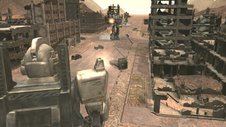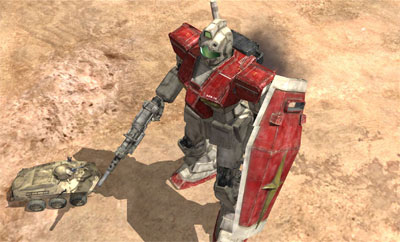

Model number: GT-9600-D
Technical and Historical Notes
During a battle against the New UNE's massive (and beam weapon-proof) NRX-010 Gable mobile suit, Roybea Loy's GT-9600 Gundam Leopard was heavily damaged, as his was the only unit among the Freeden's mobile suit complement armed with a significant number of conventional, non-beam weapons. Following the battle, the Freeden's ever-resourceful mobile suit mechanic, young Kid Salsamille, set to work to rebuild Roybea's suit. The refurbished unit was renamed GT-9600-D Gundam Leopard Destroy, and its weaponry loadout was overhauled, replacing many of its old conventional arms with a greater number of beam weapons. As a result, the Leopard Destroy's armament was now considered more "well-balanced", thus helping Roybea to better use his Gundam against the increasingly powerful New UNE military.
The Leopard Destroy, now repainted in dashing red and white, had a more balanced artillery than its previous form. The single left-arm-mounted gatling was replaced with a pair of beam gatlings which were mounted over the Leopard Destroy's forearms. The standard grenade launcher, previously located on the right hand, was replaced by set of fire linked beam cannons. The shoulders had an 11-tube missile launcher and a twin-barreled beam cannon attached, and the head vulcans were removed to make way for beam vulcans.
The Leopard Destroy also had a few other special features which weren't made much use of. Presumably, the Flash System which allowed a Newtype pilot to control a set of Ft-9600 Gt-Bit Mobile Suits was still installed in the Leopard Destroy, despite Roybea Roy lacking the Newtype powers necessary to perform such a task. It also retained a set of hardpoints which allowed it to dock with Paula Shisu's G-Falcon, an Old United Nations Earth fighter designed to support the original Gundam trio fielded by the Federation. When docked with the G-Falcon, the Leopard Destroy could take to the skies and launch a bombing raid from above. This feature was only ever tested once, as the Freeden's crew made its way to space before long.
Pilot: Roybea Loy















